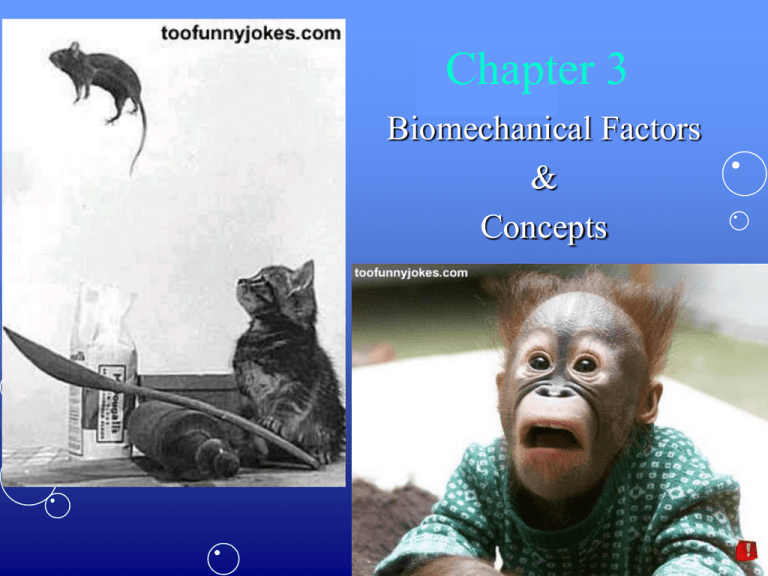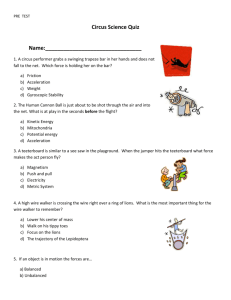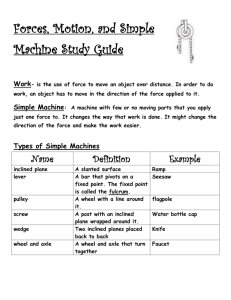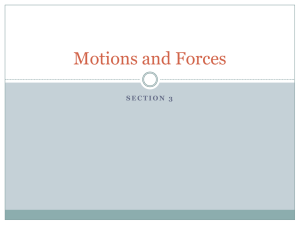Chapter 3
advertisement

Chapter 3 Biomechanical Factors & Concepts • Biomechanics: – The study ofClick mechanics as it relates to functional Here analysis of biological systems. and anatomical – Mechanics: • The study of physical actions of forces. Divided into: – Statics: the study of systems that are in a constant state of motion • At rest with no motion or • Moving at a constant velocity without acceleration • (Forces acting on the body being in balance) – Dynamics: they study of systems in motion with acceleration. • (Unequal forces acting on the body causing it to be unbalanced) • Machines of the Body: – Used to increase or multiply the applied force (muscular contraction) in performing a task (to cause, control, prevent → push, pull, hold) to provide a mechanical advantage. • Mechanical advantage: – Enables us to apply a relatively small force to move a much greater resistance – Determined by dividing load by effort: • Machines function to: – – – – Balance multiple forces Enhance force Enhance range of motion and speed of movement Alter the resulting direction of an applied force Musculoskeletal System Machines • Levers • Wheel/Axles • Pulleys Levers Humans move through a system of levers that cannot be changed, but can be used more effectively Lever: – A rigid bar that turns around an axis of rotation, or fulcrum. – Three Points of a Lever 1. Axis (A): • 2. Force (F): • 3. The point of rotation (joint) about which the lever moves The point of force application (usually muscle insertion) Resistance (R): • The point of resistance application • Center of gravity of lever or • Location of an external resistance Note: The arrangement of these three points determines the type of lever & which kind of motion it is best suited First Class Lever Axis (A) is between Force (F) and Resistance (R) • If axis is midway between force and resistance = – Balanced movement • If axis is close to the force = – Speed and range of motion • If axis is close to resistance = – Force | Force Arm • FAR Anatomical Examples 1st F Head on Neck || Triceps Press A Resistance Arm | R Second Class Lever Resistance (R) is between Axis (A) and Force (F) • Large resistance can be moved with relatively small force • Designed to produce force movements • ARF 2nd | Resistance Arm | | Force Arm Anatomical Examples A Heel Raises R | F Push ups Third Class Lever Force (F) is between Axis (A) and Resistance (R) • Requires large force to move a relatively small resistance • Designed for speed and range of motion • Most levers in the human body are this type | Force Arm • AFRAnatomical Examples | 3rd A Biceps Curl | Resistance Arm F Knee Flexion | R Mechanical Advantage of Levers may be determined using the following equations: • Mechanical Advantage • Mechanical Advantage = = Resistance Length of force arm Force Length of resistance arm Torque • Torque (moment of force) – the turning effect of an eccentric force – Eccentric force: force applied in a direction not in line with the center or rotation of an object with a fixed axis – For rotation to occur, an eccentric force must be applied – In the human body, the contracting muscle applies an eccentric force (not to be confused with an eccentric contraction) to the bone on which it attaches and causes the bone to rotate about an axis at the joint – The amount of torque can be determined by multiplying the amount of force by force arm Force Arm • Force arm: the distance between the location of force and the axis – Distance from joint to where the muscle attaches – Also known as moment arm or torque arm – The greater the distance of force arm, the more torque produced by the force Resistance Arm • Resistance Arm: the distance between the axis and the point of resistance application – Distance from joint to center of gravity of distal segment Inverse Relationship Between Length of the Two Lever Arms • Longer force arm = less force required (assuming resistance and resistance arm are constant) • Shorter resistance arm = greater resistance moved (assuming force and force are remain constant) Proportional Relationship Between Force & Resistance Components • ↑ Resistance requires ↑ Force • ↑ Resistance arm length requires ↑ Force arm length • ↑ Force or force arm allows ↑ resistance to be moved • Slight variations - impact on mechanical advantage Human leverage System • Built for speed & ROM @ expense of force • Short force arm & long resistance arm requires great strength to produce movement • Longer lever arm = more effective in ↑ velocity Torque, Length of Lever Arms, Angle of Resistance & Angle of Muscle Pull Equations: •• EMC: Effective Muscular Component – EMC = Muscular Force (MF) x Muscular Force Arm (MFA) x Sine of Angle of • ERC: Muscle Effective Pull (AMP)Resistive Component – ERC = Resistive Force (RF) x Resistive Force Arm (RFA) x Sine of Angle of Resistance (AR) • Note: When working these problems determine: EMC = MF x MFA x sin AMP – Example: Type of muscle contraction = 100 x 2” =x100 sin 90° – Muscular Relative Force speed of movement = 200 Force = 40 Resistive Muscular 2” ERC = RF xForce RFAArm x sin= AR Resistive 10” = 40 x Force 10” Arm x sin= 90° Angle of Muscle Pull = 90° = 400 Angle of Resistance = 90° Eccentric Contraction – Fast Calculate EMC and ERC movement AMP COG 90° AR 90° MFA RFA Wheels and Axles • Used primarily range If a wheel radiustoisenhance 3 times speed greaterand than the of motion theaxle, musculoskeletal system radius ofinthe due to the longer force • Center the wheel axle bothadvantage correspond to arm, theofwheel has aand mechanical the fulcrum over the axle • Both the radius of the wheel and the radius of – The outside of the wheel will turn arms at a speed 3 the axle correspond to the force times that of the axle – The distance that the outside of the wheel turns will be 3 Joint: times that of the outside axle Axle: Outside of Wheel: Force: Pulleys • Single pulleys have a fixed axle – function to change the effective direction of force application – have a mechanical advantage of 1 • Every additional rope connecting to moveable pulleys increases the mechanical advantage by 1 Joint: Pulley: Force: Force Application: Movement: Laws of motion and physical activities • Body motion is produced or started by some action of muscular system • Motion cannot occur without a force • Muscular system is source of force in humans • Two types of motion – linear motion – angular motion • Laws of motion and physical activities Linear motion (translatory motion) - motion along a line – rectilinear motion - motion along a straight line – curvilinear motion - motion along a curved line • Linear displacement - distance that a system moves in a straight line • Laws of motion and physical activities Angular motion (rotary motion) - rotation around an axis – In the body, the axis of rotation is provided by the various joints • Linear & angular motion are related – angular motion of the joints produces the linear motion of walking • Laws of motion and physical activities Sports ex. - cumulative angular motion of the joints imparts linear motion to a thrown object (ball, shot) or to an object struck with an instrument (bat, racket) • Laws of motion and physical activities Displacement - actual distance that the object has been displaced from its original point of reference • Distance - actual sum length of measurement traveled – object may have traveled a distance of 10 meters along a linear path in two or more directions but only be displaced from its original reference point by 6 meters Laws of motion and physical activities • Angular displacement - change in location of a rotating body • Linear displacement - distance that a system moves in a straight line • Speed - how fast an object is moving or distance that an object moves in a specific amount of time • Velocity - includes the direction & describes the rate of displacement Laws of motion and physical activities • Newton's laws of motion have many applications to physical education activities and sports Law of Inertia • A body in motion tends to remain in motion at the same speed in a straight line unless acted on by a force; a body at rest tends to remain at rest unless acted on by a force • Muscles produce force to start, stop, accelerate, decelerate & change the direction of motion Law of Inertia • Inertia - resistance to action or change – In human movement, inertia refers to resistance to acceleration or deceleration – tendency for the current state of motion to be maintained, regardless of whether the body segment is moving at a particular velocity or is motionless – the reluctance to change status; only force can change status Law of Inertia • The greater an object’s mass, the greater its inertia – the greater the mass, the more force needed to significantly change an object’s inertia • Examples – Sprinter in starting blocks must apply considerable force to overcome his resting inertia – Runner on an indoor track must apply considerable force to overcome moving inertia & stop before hitting the wall – Thrown or struck balls require force to stop them Law of Inertia • Force is required to change inertia – Any activity carried out at a steady pace in a consistent direction will conserve energy – Any irregularly paced or directed activity will be very costly to energy reserves – Ex. handball & basketball are so much more fatiguing than jogging or dancing From Hamilton N, Luttgens K: Kinesiology: scientific basis of human motion, ed 10, 2002, McGraw-Hill. Law of Acceleration • A change in the acceleration of a body occurs in the same direction as the force that caused it. The change in acceleration is directly proportional to the force causing it and inversely proportional to the mass of the body. Law of Acceleration • Acceleration - the rate of change in velocity – To attain speed in moving the body, a strong muscular force is generally necessary • Mass - the amount of matter in the body – affects the speed & acceleration in physical movements Law of Acceleration • A much greater force is required from the muscles to accelerate a 230-pound man than than to accelerate a 130-pound man to the same running speed • A baseball maybe accelerated faster than a shot because of the difference in weight • The force required to run at half speed is less than the force required to run at top speed • To impart speed to a ball or an object, the body part holding the object must be rapidly accelerated Law of Reaction • For every action there is an opposite and equal reaction. – As we place force on a surface by walking over it, the surface provides an equal resistance back in the opposite direction to the soles of our feet – Our feet push down & back, while the surface pushes up & forward • Force of the surface reacting to the force we place on it is ground reaction force Law of Reaction • We provide the action force while the surface provides the reaction force – easier to run on a hard track than on a sandy beach due to the difference in the ground reaction forces of the two surfaces – track resists the runner's propulsion force, and the reaction drives the runner ahead From Hamilton N, Luttgens K: Kinesiology: scientific basis of human motion, ed 10, 2002, McGraw-Hill. Law of Reaction – sand dissipates the runner's force reducing the reaction force with the apparent loss in forward force & speed – sprinter applies a force in excess of 300 pounds on his starting blocks, which resist with an equal force – in flight, movement of one part of the body produces a reaction in another part because there is no resistive surface to supply a reaction force Friction • Friction - force that results from the resistance between surfaces of two objects from moving upon one another – Depending increased or decreased friction may be desired – To run, we depend upon friction forces between our feet & the ground so that we may exert force against the ground & propel ourselves forward Friction – With slick ground or shoe surface friction is reduced & we are more likely to slip – In skating, we desire decreased friction so that we may slide across the ice with less resistance Friction • Static friction or kinetic friction – Static friction - the amount of friction between two objects that have not yet begun to move – Kinetic friction - friction occurring between two objects that are sliding upon one another Friction • Static friction is always greater than kinetic friction – It is always more difficult to initiate dragging an object across a surface than to continue dragging – Static friction may be increased by increasing the normal or perpendicular forces pressing the two objects together such as in adding more weight to one object sitting on the other object Friction • To determine the amount of friction forces consider both forces pressing the two objects together & the coefficient of friction – depends upon the hardness & roughness of the surface textures • Coefficient of friction - ratio between force needed to overcome the friction over the force holding the surfaces together Friction • Rolling friction - resistance to an object rolling across a surface such as a ball rolling across a court or a tire rolling across the ground – Rolling friction is always much less that static or kinetic friction Balance, equilibrium, & stability • Balance - ability to control equilibrium, either static or dynamic • Equilibrium - state of zero acceleration where there is no change in the speed or direction of the body – static or dynamic • Static equilibrium - body is at rest or completely motionless Balance, equilibrium, & stability • Dynamic equilibrium - all applied & inertial forces acting on the moving body are in balance, resulting in movement with unchanging speed or direction • To control equilibrium & achieve balance, stability needs to be maximized • Stability is the resistance to a – change in the body's acceleration – disturbance of the body's equilibrium Balance, equilibrium, & stability • Stability is enhanced by determining body's center of gravity & appropriately changing it • Center of gravity - point at which all of body's mass & weight are equally balanced or equally distributed in all directions • Balance - important in resting & moving bodies Balance, equilibrium, & stability • Generally, balance is desired • Some circumstances exist where movement is improved when the body tends to be unbalanced • General factors applicable to enhancing equilibrium, maximizing stability, & ultimately achieving balance: 1. A person has balance when the center of gravity falls within the base of support Balance, equilibrium, & stability 2. A person has balance in the direct proportion to the size of the base The larger the base of support, the more balance 3. A person has balance depending on the weight (mass) The greater the weight, the more balance 4. A person has balance, depending on the height of the center of gravity The lower the center of gravity, the more balance Balance, equilibrium, & stability 5. A person has balance, depending on where the center of gravity is in relation to the base of support Balance is less if the center of gravity is near the edge of the base When anticipating an oncoming force, stability may be improved by placing the center of gravity nearer the side of the base of support expected to receive the force Balance, equilibrium, & stability 6. In anticipation of an oncoming force, stability may be increased by enlarging the size of the base of support in the direction of the anticipated force. 7. Equilibrium may be enhanced by increasing the friction between the body & the surfaces it contacts 8. Rotation about an axis aids balance A moving bike is easier to balance than a stationary bike Balance, equilibrium, & stability 9. Kinesthetic physiological functions contribute to balance The semicircular canals of the inner ear, vision, touch (pressure), & kinesthetic sense all provide balance information to the performer Balance and its components of equilibrium and stability are essential in all movements and are all affected by the constant force of gravity as well as by inertia Balance, equilibrium, & stability • In walking a person throws the body in and out of balance with each step • In rapid running movements where moving inertia is high, the center of gravity has to be lowered to maintain balance when stopping or changing direction • In jumping activities the center of gravity needs to be raised as high as possible Force • Muscles are the main source of force that produces or changes movement of a body segment, the entire body, or some object thrown, struck, or stopped • Strong muscles are able to produce more force than weak muscles – both maximum and sustained exertion over a period of time Force • Forces either push or pull on an object in an attempt to affect motion or shape • Without forces acting on an object there would be no motion • Force - product of mass times acceleration • Mass - amount of matter in a body Force • The weight of a body segment or the entire body X the speed of acceleration determines the force – Important in football – Also important in activities using only a part of the body – In throwing a ball, the force applied to the ball is equal to the weight of the arm times the speed of acceleration of the arm – Leverage factors are also important Force Force = mass x acceleration F=MxA • Momentum (quantity of motion) - equal to mass times velocity • The greater the momentum, the greater the resistance to change in the inertia or state of motion Force • Many activities, particularly upper extremity, require a summation of forces from the beginning of movement in the lower segment of the body to the twisting of the trunk and movement at the shoulder, elbow, and wrist joints • Ex. golf drive, shot-putting, discus and javelin throwing Mechanical loading basics • Significant mechanical loads are generated & absorbed by the tissues of the body • Internal or external forces may causing these loads • Only muscles can actively generate internal force, but tension in tendons, connective tissues, ligaments, and joints capsules may generate passive internal forces Mechanical loading basics • External forces are produced from outside the body & originate from gravity, inertia, or direct contact • All tissues, in varying degrees, resist changes in their shape • Tissue deformation may result from external forces, but can result from internally generated forces Mechanical loading basics • Internal forces can – fracture bones – dislocate joints – disrupt muscles & connective tissues • To prevent injury or damage from tissue deformation the body must be used to absorb energy from both internal & external forces Mechanical loading basics • It is advantageous to absorb force over larger aspects of our body rather than smaller and to spread the absorption rate over a greater period of time • Stronger & healthier tissues are more likely to withstand excessive mechanical loading & the resultant excessive tissue deformation Mechanical loading basics • Excessive tissue deformation due to mechanical loading may result from – – – – – Tension (stretching or strain) Compression Shear Bending Torsion (twisting) Throwing • In the performance of various sport skills such as throwing, many applications of the laws of leverage, motion, and balance may be found • In throwing, the angular motion of the levers (bones) of the body (trunk, shoulder, elbow, and wrist) is used to give linear motion to the ball when it is released Throwing • In throwing, the individual's inertia & the ball's inertia must be overcome by the application of force (Law of inertia) • Muscles of the body provide the force to move the body parts & the ball • Law of acceleration is in effect with the muscular force necessary to accelerate the arm, wrist, & hand Throwing • The greater the force (mass X acceleration) that a person can produce, the faster the arm will move, and thus the greater the speed that will be imparted to the ball • The reaction of the feet against the surface on which the subject stands applies the law of reaction Throwing • The longer the lever, the greater the speed that can be imparted to the ball – The body from the feet to the fingers can be considered as one long lever – The longer the lever, from natural body length or the body movements to the extended backward position, the greater will be the arc through which it accelerates and thus the greater the speed imparted to the thrown object Throwing • Short levers are advantageous in taking less total time to release the ball • Balance or equilibrium is a factor in throwing when the body is rotated posteriorly in the beginning of the throw – the body is moved nearly out of balance to the rear, – balance changes again with the forward movement – balance is reestablished with the follow-through when the feet are spread and the knees & trunk are flexed to lower the center of gravity Web Sites Biomechanics: The Magazine of Body Movement and Medicine www.biomech.com/ COSI Hands-on science centers www.cosi.org/onlineExhibits/simpMach/sm1.swf – A Flash site demonstrating simple machine explanations Edquest www.edquest.ca/pdf/sia84notes.pdf – Text, pictures, and illustrations on simple and complex machines GRD Training Corporation www.physchem.co.za/Motion/Motion%20Index.htm – Explanations of physics principles for in motion with quizzes Web Sites Integrated Publishing www.tpub.com/content/engine/14037/index.htm – Engine mechanics International Society of Biomechanics www.isbweb.org/ – Software, data, information, resources, yellow pages, conferences. James Madison Memorial High School www.madison.k12.wi.us/jmm/isp/U7PDF08.pdf – A pdf file explaining the six types of simple machines Kinesiology Biomechanics Classes www.uoregon.edu/~karduna/biomechanics/kinesiology.htm – A listing of numerous biomechanics and kinesiology class site on the web with many downloadable presentations and notes Web Sites Optusnet.com www.members.optusnet.com.au/ncrick/converters/moment.html – Conversion formulas for physics variables The Physics Classroom www.glenbrook.k12.il.us/gbssci/phys/Class/BBoard.html – Numerous topics including the laws of motion and other physics principles Physics Concepts—Simple Machines www.ceeo.tufts.edu/robolabatceeo/K12/classroom/lever.asp – An overview of physics concepts involved in the study of biomechanics. Web Sites Sports Coach—Levers www.brianmac.demon.co.uk/levers.htm – A basic review of levers with excellent links to the study of muscle training & function. Worsley School www.wcsscience.com/simple/machines.html – Detailed explanations and illustrations on simple machines






